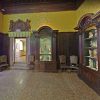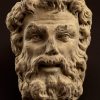Some examples from the workshop store of the sculptor Giovanni Maria Morlàiter have recently been placed in the four late 17th-century walnut cupboards. These include terracotta and rammed earth casts and models. The workshop store, which remained intact after the sculptor’s death, was sold to the heirs of the patrician Marcantonio Michièl, then passed into the Donà delle Rose collection, from which it was purchased by the Town Council of Venice in 1935.
Altogether it consists of a hundred or so pieces, and is an extraordinary testimony to the creative methods of an 18thcentury sculptor, that is to say to the moment when the artist models the clay according to his first ideas which will then be transferred into the finished marble work. Alongside these preparatory studies, some beautifully-finished complete models have survived; these the sculptor presented to his clients for the final approval of the work. The examples displayed here reveal all Morlaiter’s artistic qualities. He was the sculptor most able to transfer the vibrant light effects of contemporary painting into the three-dimensional form; so much so that he was often compared for the freshness of his execution to Sebastiano Ricci, who was in fact his close friend.
In this selection we can admire the preparatory models for works made for churches, but also models for garden statues and portraits and a splendid model for a processional sign.
There is also a complete study for an altar relief, while the delightful little rammed earth cherubs in the showcase on the right were probably designed to be made in porcelain. The mask of a bearded man is the model for the arch keystone which can be seen in the courtyard of Ca’Rezzonico near the water entrance.
In his workshop store Morlaiter also kept models by other sculptors. This is the case of the four busts and the pair of cherubs on the top shelves of the cupboards: these are the work of Enrico Merengo, Morlaiter’s master. Two rare models (only four are known of) showing a Ceres for a garden statue, and a preparatory Angel for the altar of the church of Santa Maria della Salute are instead by the sculptor Giusto Le Court, the so-called “Adriatic Bernini”, who introduced the forms of Roman Baroque to Venice.
A shaped canvas in a special stucco frame has been adapted for the ceiling. The painting, The Allegory of Merit is by a Rovigo artist, Mattia Bortoloni, a pupil of Antonio Balestra and prolific fresco painter in Venice, the Veneto, Lombardy and Piedmont.

